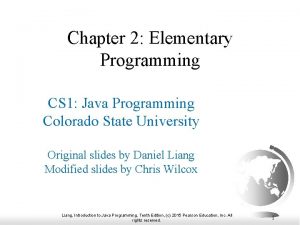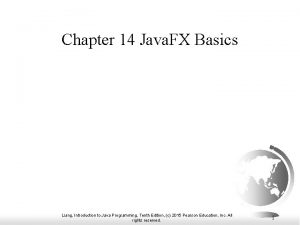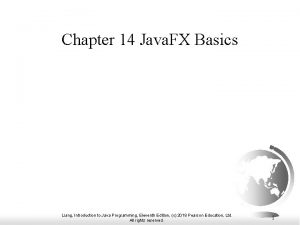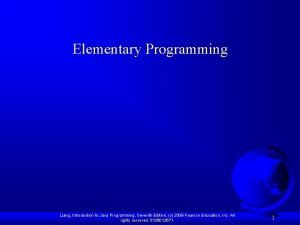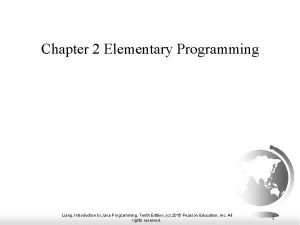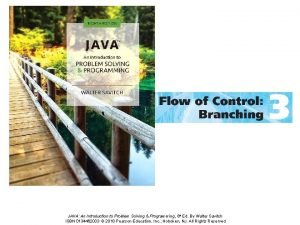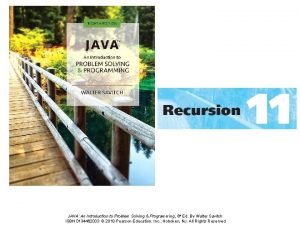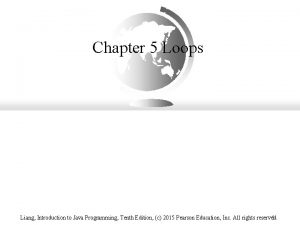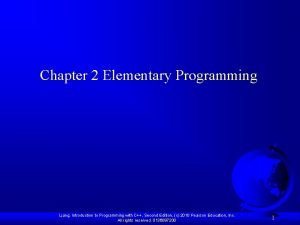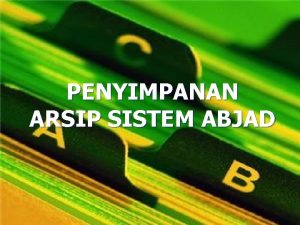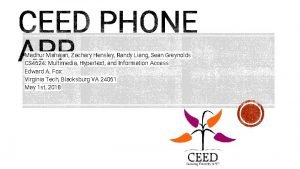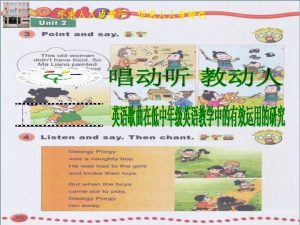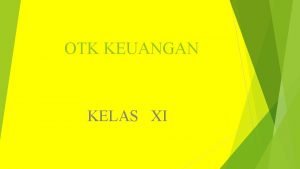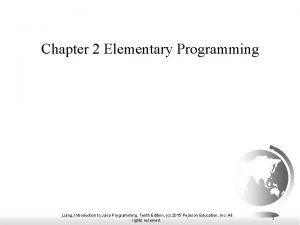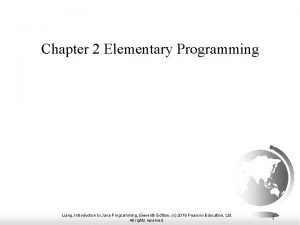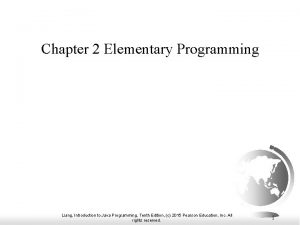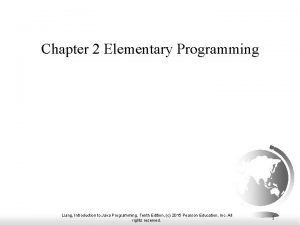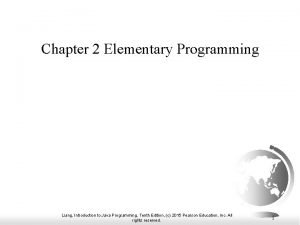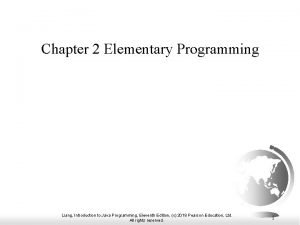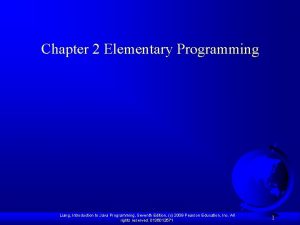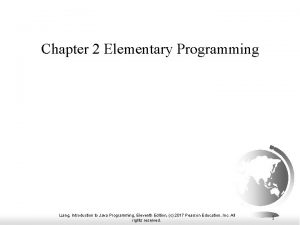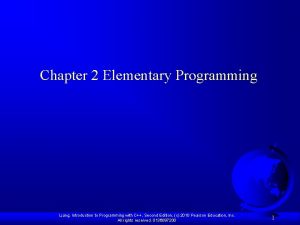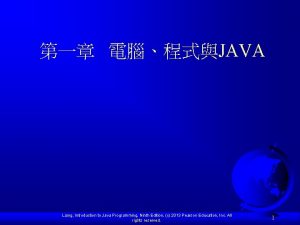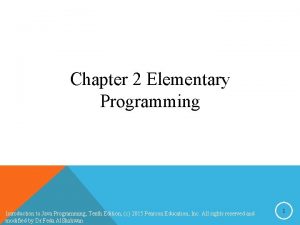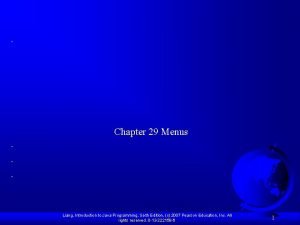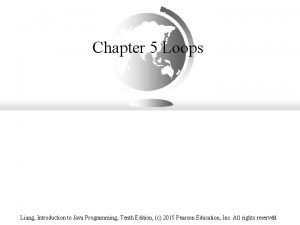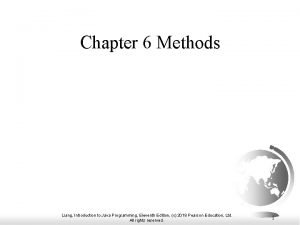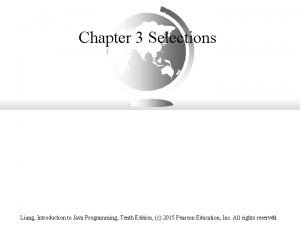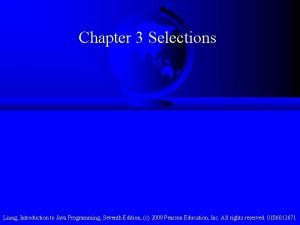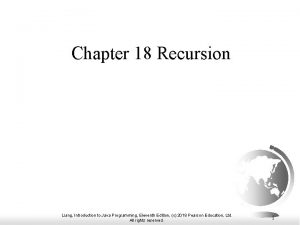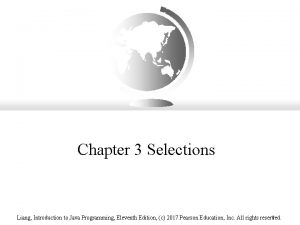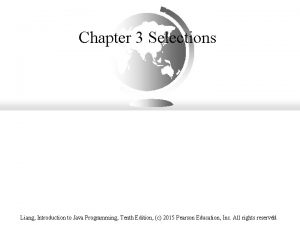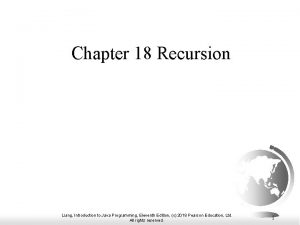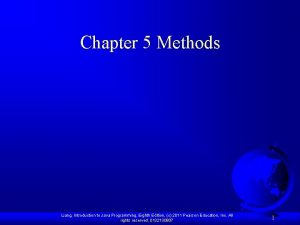Chapter 2 Elementary Programming Liang Introduction to Java

























- Slides: 25

Chapter 2 Elementary Programming Liang, Introduction to Java Programming, Tenth Edition, (c) 2015 Pearson Education, Inc. All rights reserved. 1

NOTE Calculations involving floating-point numbers are approximated because these numbers are not stored with complete accuracy. For example, System. out. println(1. 0 - 0. 1); displays 0. 500000001, not 0. 5, and System. out. println(1. 0 - 0. 9); displays 0. 0999999998, not 0. 1. Integers are stored precisely. Therefore, calculations with integers yield a precise integer result. Liang, Introduction to Java Programming, Tenth Edition, (c) 2015 Pearson Education, Inc. All rights reserved. 2

Exponent Operations System. out. println(Math. pow(2, 3)); // Displays 8. 0 System. out. println(Math. pow(4, 0. 5)); // Displays 2. 0 System. out. println(Math. pow(2. 5, 2)); // Displays 6. 25 System. out. println(Math. pow(2. 5, -2)); // Displays 0. 16 Liang, Introduction to Java Programming, Tenth Edition, (c) 2015 Pearson Education, Inc. All rights reserved. 3

Number Literals A literal is a constant value that appears directly in the program. For example, 34, 1, 000, and 5. 0 are literals in the following statements: int i = 34; long x = 1000000; double d = 5. 0; Liang, Introduction to Java Programming, Tenth Edition, (c) 2015 Pearson Education, Inc. All rights reserved. 4

Integer Literals An integer literal can be assigned to an integer variable as long as it can fit into the variable. A compilation error would occur if the literal were too large for the variable to hold. For example, the statement byte b = 1000 would cause a compilation error, because 1000 cannot be stored in a variable of the byte type. An integer literal is assumed to be of the int type, whose value is between -231 (-2147483648) to 231– 1 (2147483647). To denote an integer literal of the long type, append it with the letter L or l. L is preferred because l (lowercase L) can easily be confused with 1 (the digit one). Liang, Introduction to Java Programming, Tenth Edition, (c) 2015 Pearson Education, Inc. All rights reserved. 5

Floating-Point Literals Floating-point literals are written with a decimal point. By default, a floating-point literal is treated as a double type value. For example, 5. 0 is considered a double value, not a float value. You can make a number a float by appending the letter f or F, and make a number a double by appending the letter d or D. For example, you can use 100. 2 f or 100. 2 F for a float number, and 100. 2 d or 100. 2 D for a double number. Liang, Introduction to Java Programming, Tenth Edition, (c) 2015 Pearson Education, Inc. All rights reserved. 6

double vs. float The double type values are more accurate than the float type values. For example, System. out. println("1. 0 / 3. 0 is " + 1. 0 / 3. 0); System. out. println("1. 0 F / 3. 0 F is " + 1. 0 F / 3. 0 F); Liang, Introduction to Java Programming, Tenth Edition, (c) 2015 Pearson Education, Inc. All rights reserved. 7

Scientific Notation Floating-point literals can also be specified in scientific notation, for example, 1. 23456 e+2, same as 1. 23456 e 2, is equivalent to 123. 456, and 1. 23456 e-2 is equivalent to 0. 0123456. E (or e) represents an exponent and it can be either in lowercase or uppercase. Liang, Introduction to Java Programming, Tenth Edition, (c) 2015 Pearson Education, Inc. All rights reserved. 8

Arithmetic Expressions is translated to (3+4*x)/5 – 10*(y-5)*(a+b+c)/x + 9*(4/x + (9+x)/y) Liang, Introduction to Java Programming, Tenth Edition, (c) 2015 Pearson Education, Inc. All rights reserved. 9

How to Evaluate an Expression Though Java has its own way to evaluate an expression behind the scene, the result of a Java expression and its corresponding arithmetic expression are the same. Therefore, you can safely apply the arithmetic rule for evaluating a Java expression. Liang, Introduction to Java Programming, Tenth Edition, (c) 2015 Pearson Education, Inc. All rights reserved. 10

Problem: Converting Temperatures Write a program that converts a Fahrenheit degree to Celsius using the formula: Note: you have to write celsius = (5. 0 / 9) * (fahrenheit – 32) Fahrenheit. To. Celsius Liang, Introduction to Java Programming, Tenth Edition, (c) 2015 Pearson Education, Inc. All rights reserved. Run 11

Problem: Displaying Current Time Write a program that displays current time in GMT in the format hour: minute: second such as 1: 45: 19. The current. Time. Millis method in the System class returns the current time in milliseconds since the midnight, January 1, 1970 GMT. (1970 was the year when the Unix operating system was formally introduced. ) You can use this method to obtain the current time, and then compute the current second, minute, and hour as follows. Show. Current. Time Run Liang, Introduction to Java Programming, Tenth Edition, (c) 2015 Pearson Education, Inc. All rights reserved. 12

Show. Current. Time. java F Listing 2. 7 on page 55 Liang, Introduction to Java Programming, Tenth Edition, (c) 2015 Pearson Education, Inc. All rights reserved. 13

Augmented Assignment Operators Liang, Introduction to Java Programming, Tenth Edition, (c) 2015 Pearson Education, Inc. All rights reserved. 14

Increment and Decrement Operators Liang, Introduction to Java Programming, Tenth Edition, (c) 2015 Pearson Education, Inc. All rights reserved. 15

Increment and Decrement Operators, cont. Liang, Introduction to Java Programming, Tenth Edition, (c) 2015 Pearson Education, Inc. All rights reserved. 16

Numeric Type Conversion Consider the following statements: byte i = 100; long k = i * 3 + 4; double d = i * 3. 1 + k / 2; Liang, Introduction to Java Programming, Tenth Edition, (c) 2015 Pearson Education, Inc. All rights reserved. 17

Conversion Rules When performing a binary operation involving two operands of different types, Java automatically converts the operand based on the following rules: 1. If one of the operands is double, the other is converted into double. 2. Otherwise, if one of the operands is float, the other is converted into float. 3. Otherwise, if one of the operands is long, the other is converted into long. 4. Otherwise, both operands are converted into int. Liang, Introduction to Java Programming, Tenth Edition, (c) 2015 Pearson Education, Inc. All rights reserved. 18

Type Casting Implicit casting double d = 3; (type widening) Explicit casting int i = (int)3. 0; (type narrowing) int i = (int)3. 9; (Fraction part is truncated) What is wrong? int x = 5 / 2. 0; Liang, Introduction to Java Programming, Tenth Edition, (c) 2015 Pearson Education, Inc. All rights reserved. 19

Problem: Keeping Two Digits After Decimal Points Write a program that displays the sales tax with two digits after the decimal point. Sales. Tax Run Liang, Introduction to Java Programming, Tenth Edition, (c) 2015 Pearson Education, Inc. All rights reserved. 20

Problem: Keeping Two Digits After Decimal Points Write a program that displays the sales tax with two digits after the decimal point. Sales. Tax Run Liang, Introduction to Java Programming, Tenth Edition, (c) 2015 Pearson Education, Inc. All rights reserved. 21

Sales. Tax. java F Listing 2. 8 on page 60 Liang, Introduction to Java Programming, Tenth Edition, (c) 2015 Pearson Education, Inc. All rights reserved. 22

Problem: Computing Loan Payments This program lets the user enter the interest rate, number of years, and loan amount, and computes monthly payment and total payment. Compute. Loan Liang, Introduction to Java Programming, Tenth Edition, (c) 2015 Pearson Education, Inc. All rights reserved. Run 23

Compute. Loan. java F Listing 2. 9 on pages 63 -4 Liang, Introduction to Java Programming, Tenth Edition, (c) 2015 Pearson Education, Inc. All rights reserved. 24

BMI constants final double KILOGRAMS_PER_POUND = 0. 45359237; final double METERS_PER_INCH = 0. 0254; Liang, Introduction to Java Programming, Tenth Edition, (c) 2015 Pearson Education, Inc. All rights reserved. 25
 Daniel liang introduction to java programming
Daniel liang introduction to java programming Liang fontdemo.java
Liang fontdemo.java Liang fontdemo.java
Liang fontdemo.java Programming c
Programming c Elementary programming in java
Elementary programming in java Java introduction to problem solving and programming
Java introduction to problem solving and programming Programming and problem solving with java
Programming and problem solving with java Java introduction to problem solving and programming
Java introduction to problem solving and programming Introduction to java programming 10th edition quizzes
Introduction to java programming 10th edition quizzes Chapter 2 elementary programming
Chapter 2 elementary programming Richard seow yung liang
Richard seow yung liang Zhuo shi wo li liang
Zhuo shi wo li liang Zhong hanliang
Zhong hanliang Yuanxing liang
Yuanxing liang Amber liang
Amber liang Cara mengindeks surat
Cara mengindeks surat Zachary hensley
Zachary hensley David teo choon liang
David teo choon liang How was ma liang like
How was ma liang like Zong-liang yang
Zong-liang yang Liang jianhui
Liang jianhui Nba schedule maker
Nba schedule maker Chia liang cheng
Chia liang cheng Petugas administrasi keuangan
Petugas administrasi keuangan Umbc mechanical engineering
Umbc mechanical engineering Zong-liang yang
Zong-liang yang
